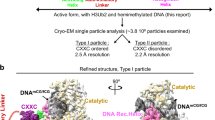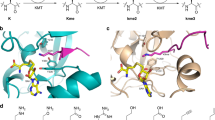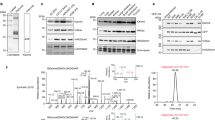Abstract
The SET domain contains the catalytic center of lysine methyltransferases that target the N-terminal tails of histones and regulate chromatin function. Here we report the structure of the SET7/9 protein in the absence and presence of its cofactor product, S-adenosyl-L-homocysteine (AdoHcy). A knot within the SET domain helps form the methyltransferase active site, where AdoHcy binds and lysine methylation is likely to occur. A structure-guided comparison of sequences within the SET protein family suggests that the knot substructure and active site environment are conserved features of the SET domain.
This is a preview of subscription content, access via your institution
Access options
Subscribe to this journal
Receive 12 print issues and online access
$189.00 per year
only $15.75 per issue
Buy this article
- Purchase on Springer Link
- Instant access to full article PDF
Prices may be subject to local taxes which are calculated during checkout




Similar content being viewed by others
References
Jenuwein, T. Trends Cell Biol. 11, 266–273 (2001).
Zhang, Y. & Reinberg, D. Genes Dev. 15, 2343–2360 (2001).
Jenuwein, T. & Allis, C.D. Science 293, 1074–1080 (2001).
Rea, S. et al. Nature 406, 593–599 (2000).
Strahl, B.D., Ohba, R., Cook, R.G. & Allis, C.D. Proc. Natl. Acad. Sci. USA 96, 14967–14972 (1999).
Wang, H. et al. Mol. Cell 8, 1207–1217 (2001).
Nishioka, K. et al. Genes Dev. 16, 479–489 (2002).
Fauman, E.B., Blumenthal, R.M. & Cheng, X. Structure and Evolution of AdoMet-dependent Methyltransferases (eds Cheng, X. & Blumenthal, R.M.) 1–38 (World Scientific, Singapore; 1999).
Fang, J. et al. Curr. Biol. 12, 1086–1099 (2002).
Nishioka, K. et al. Mol. Cell 9, 1201–1213 (2002).
Strahl, B.D. et al. Mol. Cell Biol. 22, 1298–1306 (2002).
Lachner, M. & Jenuwein, T. Curr. Opin. Cell Biol. 14, 286–298 (2002).
Zhang, X., Zhou, L. & Cheng, X. EMBO J. 19, 3509–3519 (2000).
Cheng, X. & Roberts, R.J. Nucleic Acids Res. 29, 3784–3795 (2001).
Sun, P.D. & Davies, D.R. Annu. Rev. Biophys. Biomol. Struct. 24, 269–291 (1995).
Nureki, O. et al. Acta Crystallogr. D 58, 1129–1137 (2002).
Jacobs, S.A. et al. EMBO J. 20, 5232–5241 (2001).
Jacobs, S.A. & Khorasanizadeh, S. Science 295, 2080–2083 (2002).
Luger, K., Maeder, A.W., Richmond, R.K., Sargent, D.F. & Richmond, T.J. Nature 389, 251–259 (1997).
Harp, J.M., Hanson, B.L., Timm, D.E. & Bunick, G.J. Acta Crystallogr. D 56, 1513–1534 (2000).
Coward, J.K. in The Biochemistry of Adenosylmethionine (eds Salvatore, F., Borek, E., Zappia, V., William-Ashman, H.G. & Schlenk, F.) 127–144 (Columbia University Press, New York; 1977).
Komoto, J. et al. J. Mol. Biol. 320, 223–235 (2002).
Ramakrishnan, V., Finch, J.T., Graziano, V., Lee, P.L. & Sweet, R.M. Nature 362, 219–223 (1993).
Grzesiek, S. & Bax, A. J. Am. Chem. Soc. 115, 12593–12593 (1993).
Delaglio, F. et al. J. Biomol. NMR 6, 277–293 (1995).
Johnson, B.A. & Blevins, R.A. J. Biomol. NMR 4, 603–614 (1994).
Otwinowski, Z. & Minor, W. Methods. Enzymol. 276, 307–326 (1997).
Terwilliger, T.C. & Berendzen, J. Acta Crystallogr. D 55, 849–861 (1999).
Cowtan, K. Acta Crystallogr. D 50, 760–763 (1994).
Perrakis, A., Morris, R.J. & Lamzin, V.S. Nature Struct. Biol. 6, 458–468 (1999).
Brunger, A.T. et al. Acta Crystallogr. D 54, 905–921 (1998).
Jones, T.A. & Kjeldgaard, M. O version 5.9 (Uppsala University, Uppsala; 1994).
McRee, D.E. J. Struct. Biol. 125, 156–165 (1999).
Carson, M. J. Appl. Crystallogr. 24, 958–961 (1991).
Wallace, A.C., Laskowski, R.A. & Thornton, J.M. Protein Eng. 8, 127–134 (1995).
Nicholls, A., Sharp, K.A. & Honig, B. Proteins 11, 281–296 (1991).
Acknowledgements
We thank Y. Zhang for the clone of SET7 and C.D. Allis for encouragement and support. J.M.H. is a fellow of Rett Syndrome Research Foundation. This work was supported by an NIH grant to S.K.
Author information
Authors and Affiliations
Corresponding author
Ethics declarations
Competing interests
The authors declare no competing financial interests.
Rights and permissions
About this article
Cite this article
Jacobs, S., Harp, J., Devarakonda, S. et al. The active site of the SET domain is constructed on a knot. Nat Struct Mol Biol 9, 833–838 (2002). https://doi.org/10.1038/nsb861
Received:
Accepted:
Published:
Issue Date:
DOI: https://doi.org/10.1038/nsb861



